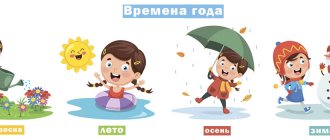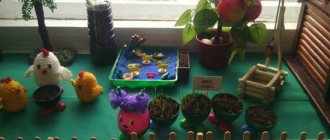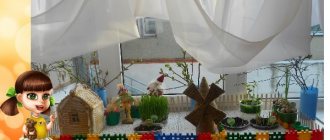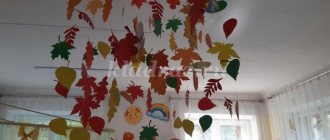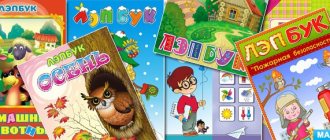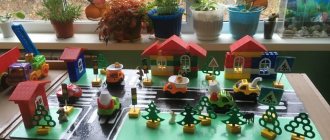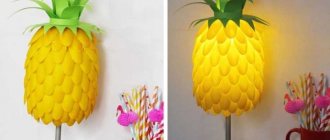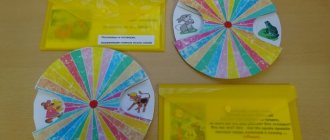Didactic manual “Miracle Tree” for kindergarten
Didactic manual “Miracle Tree” for preschool children
Didactic manual “Miracle Tree”
Description. I bring to your attention the teaching aid “The Miracle Tree”. The material is intended for kindergarten teachers. The manual can be used on lexical topics “Birds”, “Fruits”. And also for automation and differentiation of sounds. Multifunctionality lies in the use of different pictures. The manual is designed for individual and subgroup work with preschool children. Method of making the manual. Take a sheet of A4 paper, draw a picture of a tree on it or use a ready-made image. Laminate it with film for pasting textbooks.
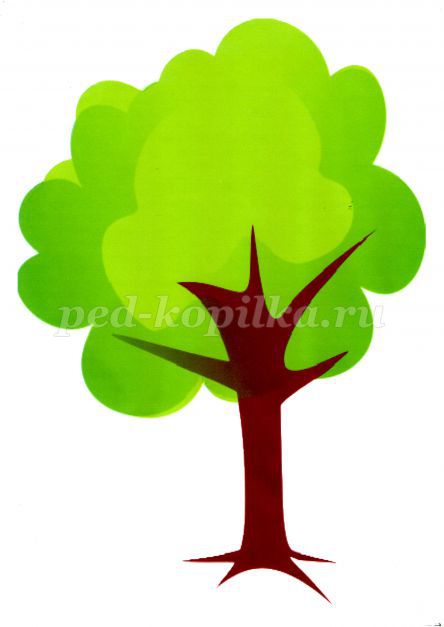
Cut nest-pockets from transparent film and attach to tree branches using double-sided tape.
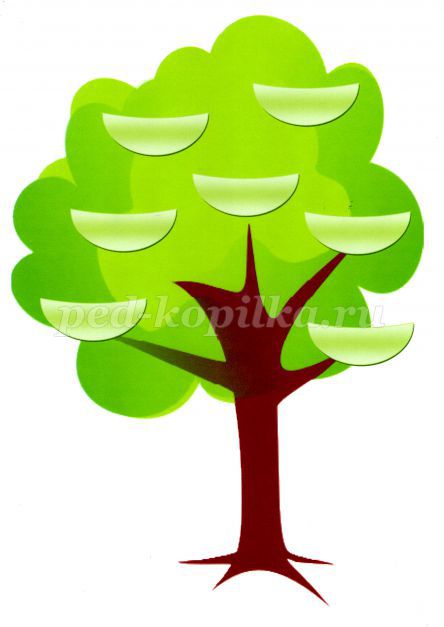
Select pictures of birds and cover them with tape.
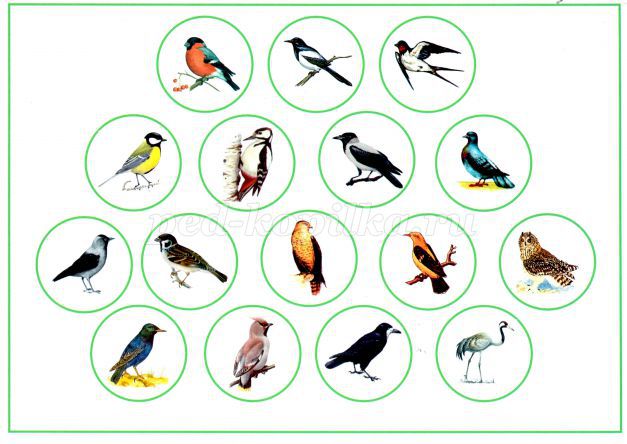
Didactic game “Birds in nests”
Purpose: To consolidate children’s knowledge and ideas about migratory and wintering birds. Clarify the name of the birds, practice recognizing birds by their description. Learn to coordinate nouns with numerals. Develop phonemic awareness, determine the presence of sound in a word. Automate the sounds L, R, Rub, S. Game options.
1 task “Say it in one word”
Pictures of birds are laid out in front of the child. The teacher asks the child to name who is shown in the pictures. Then he suggests choosing a generalizing word.
Task 2 “Wintering birds”
The teacher invites the child to select and place only wintering birds in the nests. The child resettles the birds by pronouncing their names.
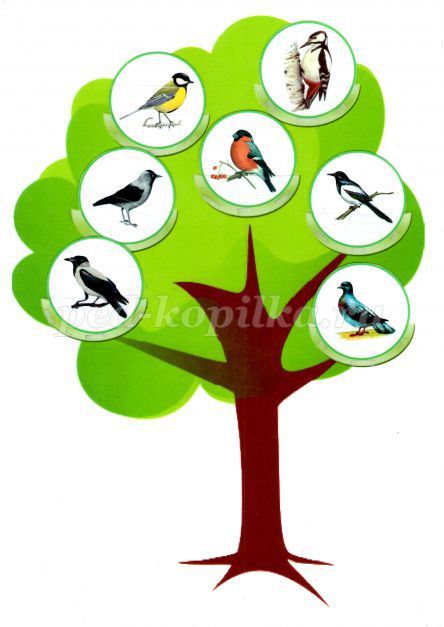
Task 3 “Count and name”
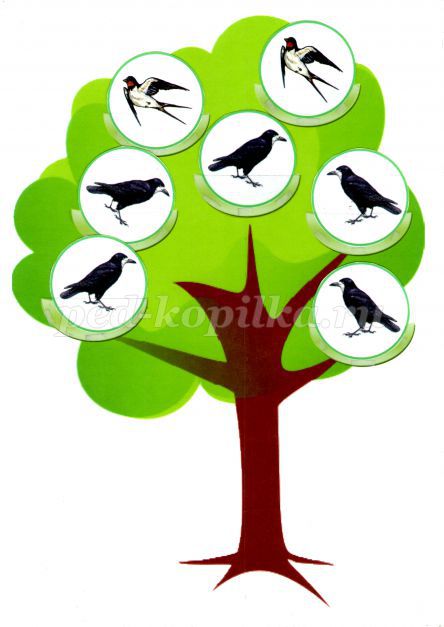
The teacher places the birds on the tree and asks the child: “How many birds have arrived?” The child counts the birds and sums them up at the end of the count. For example, one rook, two rooks...five rooks. Five rooks flew in.
Task 4 “Where is the bird sitting?”
The teacher invites the child to place the birds on a tree branch, above a tree, under a tree, on a branch. The child seats the birds, pronouncing their location.
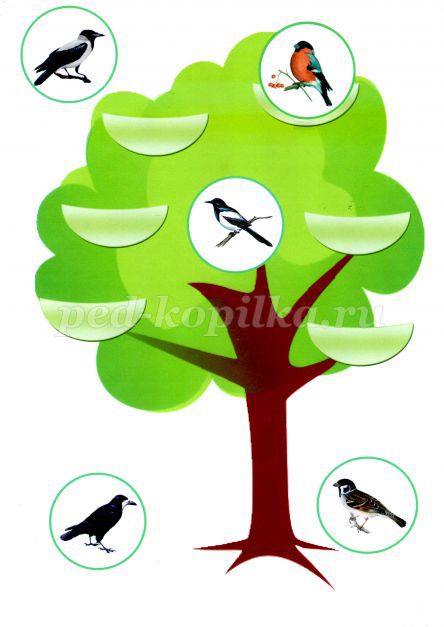
— A crow over a tree. - Magpie on a tree. - Rook under the tree. — The sparrow is to the right of the tree. — The rook is to the left of the tree. The teacher monitors the correct use of prepositional-case constructions.
Task 5 “Find out by description”
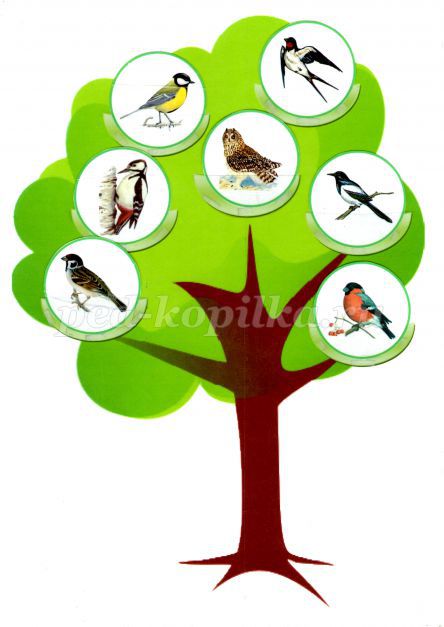
The teacher asks the child to guess riddles about birds. Nimble, fast, dexterous, pugnacious, brave, fighting ... (sparrow) Red-headed, large, smart, wintering ... (woodpecker) Nimble, cheerful, long-tailed, migratory ... (swallow) Big-eyed, sleepy, nocturnal, sedentary, wintering ... (owl) The child guesses the bird, names it and places it in the nest.
Task 6 “Birds in nests”
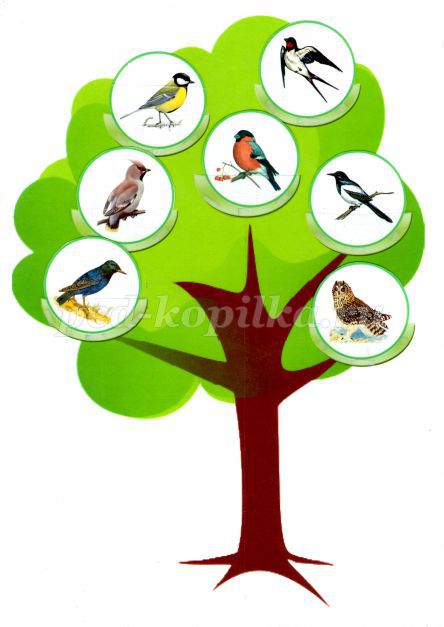
The teacher asks the child to place in the nests only those birds whose names contain the sounds S, S'. Similarly with the sounds R, Rb, L.
Task 7 “Who flew away?”
The teacher places birds on the tree whose names contain the sound S. Invites the child to look carefully and remember the birds. Then the child closes his eyes, and the teacher removes one bird. Who flew away?
Task 8 “Who’s the odd one out”
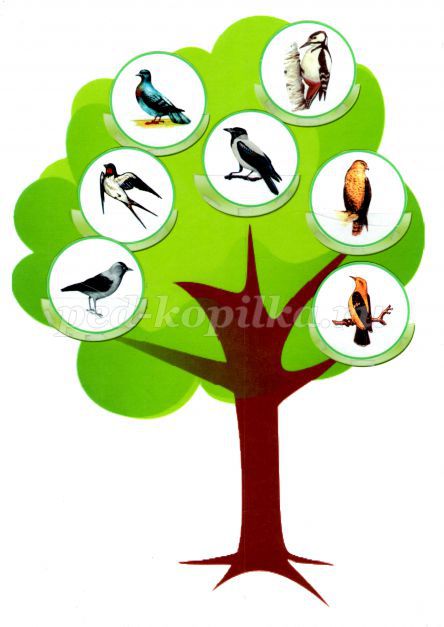
The teacher places birds in nests: jackdaw, swallow, dove, oriole, woodpecker, falcon and crow. Invites the child to look carefully and find the extra bird whose name does not have the sound L.
We recommend watching:
Do-it-yourself multifunctional game aid for preschoolers Do-it-yourself didactic aid for younger preschoolers Do-it-yourself didactic aid for kindergarten Do-it-yourself didactic aid “Paired Pictures” for kindergarten
Similar articles:
Game layout for children 4-7 years old “My City”
Multifunctional teaching aid for children 5-6-7 years old
Do-it-yourself manual for developing fine motor skills
"Miracle - Tree."
"Miracle - Tree."
Lesson on the formation of behavioral and socio-moral qualities in children of senior preschool age.
Target
: Formation of social and moral qualities in students.
Tasks
Educational
:
- cultivate a sense of goodwill, empathy, responsiveness, the need for friendly relationships;
- cultivate the desire to do good deeds.
Educational:
— to form the idea that kindness is a manifestation of the soul.
— improve dialogic and monologue forms of speech;
— improve cognitive activity;
Educational:
- stimulate the development of children’s thinking abilities;
- develop the ability to observe, highlight, compare, analyze;
— develop fine motor skills, motor activity, coordination of movements;
Equipment and attributes:
puzzles with the image of Leopold the cat; magic basket; bag; a series of pictures of a bad and a good deed; blue fabric; record player; musical accompaniment; preparations of hearts, suns; planks for the bridge; eraser, pencil, slippers (for children), scissors, watering can, book;
A series of pictures with fairy-tale characters, good and evil; glue; envelopes 4 pieces.
Preliminary conversation:
conversations on the topic of what is good and evil, bad and good deeds; looking at a series of pictures about actions, reading works of art; losing games.
Progress of the lesson.
Psychologist
: Hello guys! I'm very glad to see you all. Today is such a good day. Let's give each other smiles so that our souls will be joyful and calm. Let's hold hands and look into each other's eyes. Guys, I really love giving gifts and I have prepared a surprise for you - this is an unusual, special gift called a miracle - a tree. And his secret is that when people look at him, their hearts are filled with kindness and love, and a smile appears on their face.
(recording of thunder sounds).
The children hide with the psychologist, and when they return to the tree, they see that all the flowers and leaves on the tree have disappeared, the children do not understand what happened.
Psychologist:
- Guys, look what happened to our tree, it withered, all the flowers and leaves fell off. Why do you think this happened (children's answers)
-maybe he was bewitched, but who could do it? (audio recording)
Laughter of the evil sorceress
(children's answers.)
Psychologist
:
-Let me help you with your guesses and (tells)
-Most of the people who surround us are kind, loving people. But, despite this, there is evil in our world, the mistress of which is the sorceress Zlyuka. She doesn’t like cheerful, kind, good people and she tries to quarrel with them, make them evil, scary, disgusting, sowing seeds of fear, evil, indifference, from which trees of hatred, malice will grow, turn into dense forests and forever remain in our world, making people evil and scary. And now, in order to harm us, she bewitched our miracle tree.
“Didactic multifunctional manual “Seasons””
“Didactic multifunctional manual “Seasons””
Author: Trostyanskaya Asya Yuryevna, teacher of the municipal government preschool educational institution of the city of Novosibirsk, kindergarten No. 5 “Zvezdochka” of a combined type.
The didactic multifunctional manual “Seasons” is intended to develop children's ideas about seasonal changes in nature. The manual in a playful way will teach the child to classify, compare, find similar
qualities and differences. The child can easily talk about the characteristic features of each season. Thanks to elements with Velcro fastenings, he will be able to independently decorate the tree according to the seasons. This manual will help organize joint and independent activities during the study, consolidation of specific topics (seasons, wildlife, wintering birds, etc.). The manual “Seasons” is designed for preschool children from 3 to 7 years old.
The manual includes: - a dynamic model in the form of a three-dimensional tree, made of plywood, which is safe and environmentally friendly for children
— elements with Velcro fastenings (foliage of different colors, snowflakes, flowers, birds, fruits, flowers); available to children from 3 years of age for independent use (develops fine motor skills);
-figures of birds, insects, fruits, leaves, etc. (made of felt)
- methodological developments using the manual contain practical material for conducting classes with one child or a subgroup of children in order to study new and consolidate previously studied material - (card file of games, walks, oral folk art, wintering and migratory birds with descriptions, insects, flowers, fruits and etc).
This manual is a combination of a didactic task, the implementation of speech capabilities, visualization of specific images, and the permissibility of manipulation with these images.
Goals:
1. Improve children’s basic understanding of the seasons based on a model that contains distinctive features (leaves, snowflakes, birds, plants, animals, etc.).
2. Compose a story - a description, based on the model of a certain time of year.
3. Continue to develop the ability to depict the seasons using object modeling.
4. Foster a desire in children to work with models.
5. To introduce preschool children to the beauty of nature through the organization of joint artistic and creative activities of children, parents and teachers.
6. To develop the ability to play, performing various roles, to see the events and interests of others, to comply with norms and rules.
Tasks:
Educational:
- expand and enrich children’s ideas about the changes that occur in nature in different seasons;
— enrich vocabulary;
- intensify speech;
Developmental;
— develop the ability to correlate natural phenomena with seasonal changes;
— to form interest in cognitive activity;
Educational;
- cultivate friendly relationships with peers;
- cultivate love and respect for the environment;
The manual can be used in joint (partnership) activities of a teacher with children, educational activities in restricted moments (walks, individual work in the morning and evening hours, etc.). In organizational educational activities, gaming, problem-based learning situations, etc., children’s independent activities, and the type of activity (game, cognitive-research, motor, productive), their interest in this activity, the complexity of the material.
Expected result:
— allows you to reveal the important features of natural objects and the natural connections that exist in it;
— develops the child’s ability to consistently build conclusions, give reasons for his opinions, and compose a descriptive story;
— develops children’s cognitive abilities, interest, curiosity, imagination and creative activity;
— enriches and refines children’s knowledge about the life of animals and birds in the forest, teaches them to name the distinctive features of their appearance;
— forms mathematical representations;
— fosters emotional responsiveness;
- consolidates and systematizes the studied material, and reviewing it in the future allows you to quickly refresh your memory of the topics covered;
- helps the child, at will, organize information on the topic being studied and better understand and remember the material (considering that preschoolers have visual-figurative thinking);
- a preschool child learns to independently collect and organize information - good preparation for school;
- promotes quick memorization of poems, finger gymnastics;
- promotes increased interest in the content, independence when working with the manual, and interest on the part of parents;
- teaches a comprehensive analysis of a problem, setting tasks and solving them, creatively approaching the issue of organization and selection of information;
- develops skills of voluntary switching of attention, increases the level of visual-effective thinking and visual perception, develops visual-motor reaction in children’s activities.
The manual is mobile, accessible to children, multifunctional, suitable for both group and individual use, including with the participation of an adult;
It has didactic properties, is a means of artistic and aesthetic development of the child, introduces him to the world of art;
— variability (there are several options for using each part);
— provides playful, educational, research and creative activity for all pupils.
By using the didactic multifunctional manual “Seasons” in your work, it will be possible to prepare just such a person for a new life in new conditions. “Seasons” is a method that helps consolidate and practice acquired knowledge, which can give the desired results; this is a study that will last a lifetime.
This multifunctional didactic guide helps organize games with children: “What time of year”, When does it happen”, “Who eats what”, “Who winters where”, “What fruits do you know?”, “Count” and much more. Used on mathematics classes with additional handouts, on familiarization with the surrounding world “Wintering and migratory birds” (habitat at different times of the year), on speech development we compose descriptive stories, etc.
Exercises (games) on the theme “Seasons”
Purpose of exercises (games): development of fine motor skills; tactile sensations.
1. Exercise “Attach flowers (apples, leaves, snowflakes)”
It can be played by one or two people. It can be in the form of a timed competition.
The development of coherent speech according to this manual occurs in an inextricable connection between word and action, since during his story the child attaches the missing details to the worksheet. Children learn to formulate their statements grammatically correctly, understand and use prepositions.
1. Exercise “Place it in order”
Task: arrange the worksheets in the correct sequence one after another and tell what changes occur when the seasons change.
2. Exercise “Tell me about the time of year.” Task: talk about the signs of the selected season using the appropriate mnemonic table.
3. Exercise “Answer the question”
Questions “Where do apples grow?”, “Where do flowers grow,” etc.
Task: Answer the question using prepositions correctly.
4. Exercise “Put into baskets.” Task: classify vegetables and fruits
5. Exercise “One - many.”
Task: form the plural of a noun.
Didactic games “Seasons”
1. Game “Choose and Explain!”
Progress of the game:
On the playing field, children choose one of four seasons. The presenter shows a card corresponding to a certain time of year. Children choose and name an image if it corresponds to the time of year chosen by the child. The winner is the one who accurately and ahead of everyone uses these cards offered by the presenter.
2. Game “What’s wrong?”
Progress of the game:
You can place several mismatched pictures in different sectors and invite children to put them where they should be. Or arrange competitions: some arrange, and others decide whether it is correct or not.
To assimilate the material and make the educational game “Seasons” more interesting, it is possible for a teacher to be present in the game to enhance speech activity and use riddles.
The didactic manual helps to organize games with children: “What time of year”, When does this happen”, “What fruits do you know?”, “Count” and much more.
Game “Find out by description” Goal: to develop logical memory and imagination. Game “What is missing” Goal: to develop memory, attention, observation; exercise in the formation of the genitive case singular. Game “Walk in the Forest” Goal: to develop observation skills, introduce seasonal phenomena in winter. Game “What’s above, what’s below” Goal: to develop the ability to determine the position of objects relative to each other.
Game “When It Happens” Purpose: to consolidate children’s knowledge about the seasons. The games proposed on the topic “Winter” can also be used when considering other seasons of the year. When considering the topic “Spring”, you can play educational games “Who was awakened by the sun”, “ Who came to visit.” When considering the topic “Summer”, add the games: “One - many”, “Big - small”. When considering the topic “Autumn” - games “Stocks for the winter”, “Gifts of Autumn”. Thus, using layout “Tree. Seasons", I solve several didactic tasks: - develop visual - figurative and verbal - logical thinking; - form the ability to highlight significant connections between objects and natural phenomena; - expand the understanding of animals and insects, cultivate a caring attitude towards nature.
MAGAZINE Preschooler.RF
Multifunctional manual “Miracle Tree”.The manual is used in many areas of educational activity of children 2-3 years old and helps to achieve many goals and solve educational problems:
- Socialization.
Development of gaming activities: to develop the ability to show interest in the gaming activities of peers. Help them play nearby without interfering with each other. Develop the ability to play with peers. Develop the ability to perform several actions with one object and transfer familiar actions from one object to another. Enrich children's sensory experience, compare, correlate, group, establish the identity and difference of homogeneous objects according to one of the sensory attributes (color, shape, size). Conduct didactic games to develop attention and memory ( “What’s missing?” , “What’s extra?”, etc.), to develop hand motor skills (attaching objects to a tree or a garden bed using Velcro). Introduction to basic generally accepted norms and rules of relationships with peers and adults: develop the ability to play without quarreling, help each other and enjoy success together.
- Cognition. Sensory development: continue to work to enrich children's direct sensory experiences. Help examine objects, highlighting color, size, shape. Exercise in establishing the similarities and differences between objects that have the same name (for example: a red leaf, a green leaf, a yellow leaf). To develop the ability to name the properties of objects (an apple is green, sweet, etc.).
Formation of elementary mathematical concepts: involve children in the formation of groups of homogeneous objects. To develop the ability to distinguish the number of objects: many - one (one - many).
Formation of a holistic picture of the world, expansion of horizons: teach children to name colors, compare objects (red apple, green apple, yellow apple), select objects by identity (find the same piece of paper). Teach children to distinguish fruits (apple, pear) by appearance. To form elementary ideas about seasonal changes in nature: in autumn the leaves turn yellow and red, vegetables and fruits ripen. In winter, there are no leaves on the trees, snow falls, you can sculpt snowmen and look at snowflakes. In spring, the first leaves and flowers appear on the trees. In summer there are green leaves on the trees and flowers bloom on the grass.
- Communication. Offer individual objects (leaves, snowflakes, etc.) for independent examination as visual material. Tell children about them, encourage children to communicate with each other. Activate children's vocabulary. To develop children’s ability, following the teacher’s verbal instructions, to find objects by name, color (take an apple, attach a snowflake to a tree, remove red leaves from a tree, etc.), and name their location (pear high, leaves low). Enrich children's vocabulary with nouns denoting the names of fruits; verbs denoting actions (find, attach, remove); adjectives denoting color, size, taste, temperature (cold snowflake)
- Artistic creativity. Develop aesthetic perception. Look at the pictured tree with the children, draw their attention to how beautiful, bright, neatly made and drawn it is.
“Miracle Tree” is made of plywood and coated with Senezh . Small items are attached to the tree using Velcro.
Examples
didactic games, tasks using the “Miracle Tree”
- Name each item.
- Name the objects in one word (fruits or vegetables)
- Where do fruits grow? (on the tree)
- Name the green fruits
- Find yellow fruits
- Find green apples (etc.)
- What's extra? (there are no snowflakes in summer, etc.)
- Help the bunny cook compote
- Attach green leaves to the tree
- Pick yellow apples from the tree
- Pick 2 apples from the tree
- Attach a leaf above the apple
- Attach the pear under the leaf
- Tell me where the pear grows? (high), where is the leaf? (low)
- Which snowflake is warm or cold?
- Name the color
- What's missing?
- Find where the apple fell from the tree (into the garden bed)
- Show me the tree trunk
- Show tree branches
- Determine with your eyes closed what kind of object it is (snowflake, pear)
And also many other tasks - it all depends on the teacher’s imagination. And this is only for children of the younger group.
In middle and older groups, you can also successfully use this manual by solving other problems appropriate to the age of the children.
As the seasons change, the appearance of the tree also changes. In winter it is white, without foliage, decorated with snowflakes.
In the future you can supplement it with bullfinches and sparrows. In spring (when fruit trees begin to bloom), the tree turns over to its green side and is decorated with pink and white flowers and green leaves. In summer, the flowers move to the garden bed. And in the fall, the vegetable garden ripens, and yellow and red leaves and fruits appear on the tree - either apples or pears. In the future it will also be possible to add mushrooms.
| Next > |
